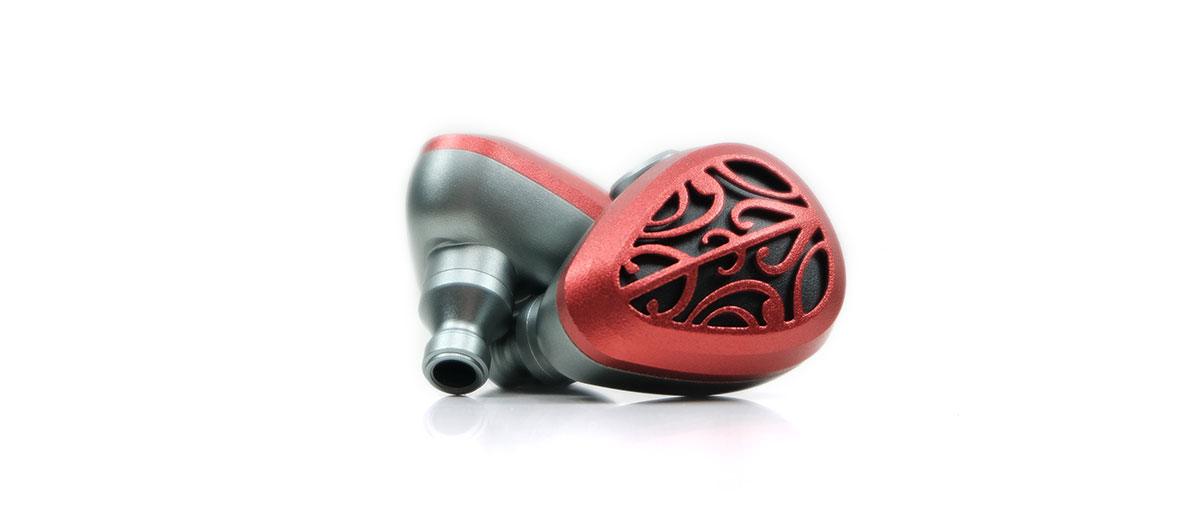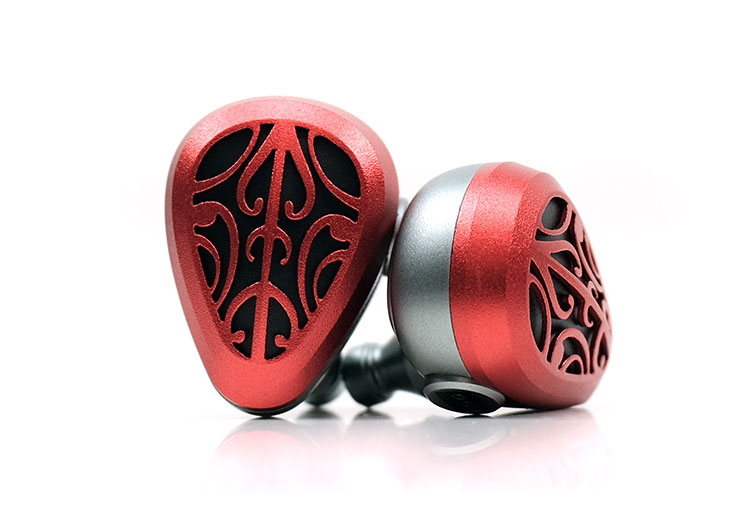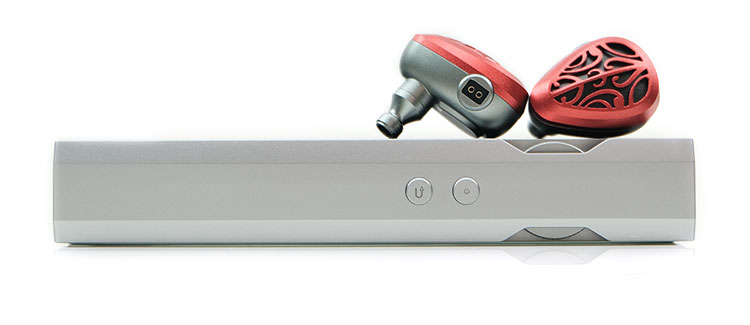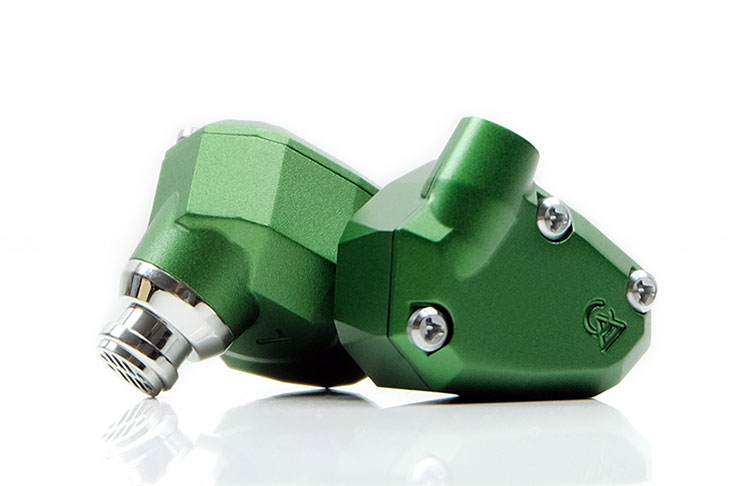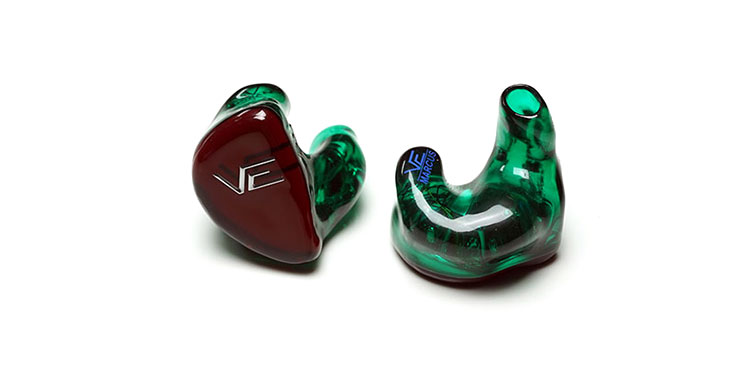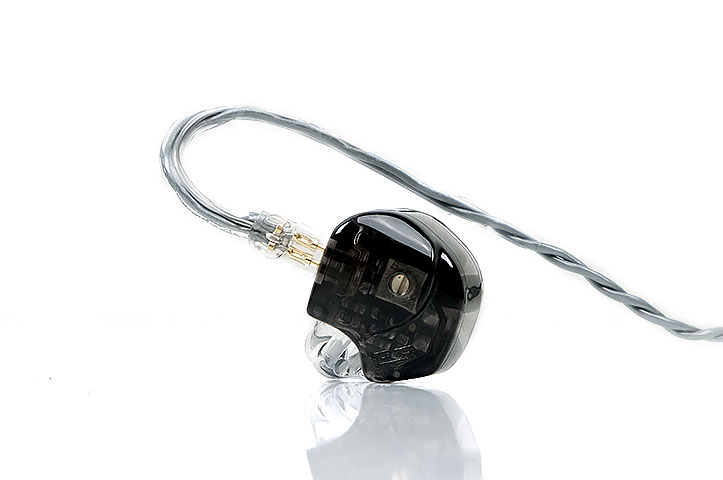Sound Impressions
Summary
The Gae Bolg is a full-bodied, rich, and smooth sounding monitor with a beefy low-end response, euphonic vocal timbre, and a relaxed but clear treble performance.
For those looking for an Andromeda 2020 alternative, the Gae Bolg is heading in the same direction with a level of coloration intended for enjoyment rather than reference listening.
However, unlike the Andromeda 2020, the Gae Bolg is bolder and heavier on the low-end, and thicker and richer in the mids and lower-treble. The two sound different as our comparison below will point out in more detail. You could almost refer to the MMR creation as its creamier more euphonic sibling.
The response curve has a bit of a low-end to midrange bias but not a huge amount of dips and valleys with a fairly controlled level of peaking at the usual key points for presence around 50-200Hz, 1-2k, and 5-7k.
The only quirk is a dip from 2-4k that is there to accentuate vocal presence over percussion energy as well as tone down on any unwanted harmonic dissonance from the treble tuning. Aside from that, nothing whacky or unusual giving it a very coherent and smooth sound from top to bottom.
Timbre
The instrumental and vocal timbre on the Gae Bolg is natural to warm sounding with a liquid edge and a relatively long decay, especially below 500Hz.
Though not heavily tilted towards sub over mid-bass it does generate a better sense of power and weight than some lighter punchy BA alternatives such as the Earsonics Purple. That dual bass BA driver has plenty of ‘welly’ but it is one of those richer enveloping experiences rather than a ram it down your throat bass response.
Though not rolled-off the Gae Bolg low-end does have gentle lift starting from around 50-Hz and a long tailwind that doesn’t really bottom out to around 800Hz bringing plenty of presence and body with it, hence that smooth fulsome lower-mids tone.
There is enough of a dip in the lower-mids for good separation and perceived articulation from those BA drivers to prevent it from too much bleed so the bloom does not cast a veil on mids clarity.
The treble on the Gae Bolg is actually fairly well extended and quite linear from 5-7/8k with a fade beyond. However, it is not a peaky curve and rarely stretches tall over the mids 1-2k bump meaning it has less of a ‘fizz’ in its response.
The 2-4k dip in the upper mids will suck a little energy from that treble curve and it’s one of the major differences between it and something like the Andromeda 2020 which is peppier and cleaner due to an elevation in the same region.
Percussion timbre in the upper mids will therefore sound a bit more relaxed with a fuller tone but less prone to sibilance and splashiness. The Gae Bolg definitely has an even-harmonic bias, particularly in female vocals which sound very natural and incredibly easy to listen to.
Staging
Staging on the Gae Bolg is more about some excellent depth, solid layering, and a vocal presence that can sound fairly forward over that 1-2k bump.
The presentation does not lack headroom but the treble does not have huge energy or uneven peaks beyond 7k so it is not a peppy sparkling affair, rather a clear but relaxed tone.
Upper-Mids presence is not as pushed as the Andromeda 2020 or the Earsonics Purple, sounding comparatively relaxed in their positioning. Very high-pitching vocals and some percussion that cross the 2-4k dip can lack a little energy and presence also.
However, lower-pitching vocals that straddle that 1-2k bump come across as big and bold and beautifully forward if slightly intimate in their delivery.
Articulate yet soulful singers such as Jamiroquai’s Jay Kay’s light chest voice technique sounds strong and clear. Heck, even Ariana Grande sounds full-bodied and forward when she drops an octave on her more intimate performances such as “Better Off” from her 2017 Sweetener album.
Channel separation and instrumental clarity on the Gae Bolg are actually excellent through the mids so staging width is much better than I expected it to be given the relaxed top-end tuning.
This is not a lean lightweight ethereal wispy soundstage and perhaps not the same level of top-end extension as the Andromeda 2020. However, imaging is engaging with a slight vocal and bass bias.
Synergy
Efficiency
The Gae Bolg is rated at 25Ω and around 98dB SPL. You will not find that SPL rating on the website hence its approximation in our review than precise as it was mentioned in an informal discussion with MMR.
This is what I would term as a medium efficiency monitor, not super sensitive like Campfire Audio monitors but not terribly hard to drive either despite that 98dB SPL rating.
Out of the 6 DAPs we tested with the Gae Bolg, we did not find a single one with background hiss or high noise floor issues using the stock single-ended cable. All of them can easily drive the Gae Bolg in low-gain mode and offer a very black background.
Swapping to an old ALO Audio SXC 24 which is also an SPC cable but with a balanced connection, all but 2 of the tested DAPs offered a similarly black background.
This included the Lotoo PAW Gold Touch, Cayin N3Pro, Luxury & Precision P6, and the Cayin N6ii with the E02 motherboard. Two DAPs did show a little bit of hiss going balanced, the FiiO M15 and the HiBy R8 with the M15 being perhaps the most noticeable of the two with their respective boost options on.
Pairings
Out of those DAPs listed above, I tended to go for those with superior separation and dynamic range such as the N6ii/E02 pairing with its dual ES9038Q2M implementation. Those DAPs that kept a very clean midrange and treble response such as the FiiO M15 also did particularly well with the Gae Bolg.
Both of these sources did really well in terms of liveliness and articulation with the Gae Bolg/E02 drawing out some excellent staging width and a better holographic sound overall.
The M15 is more neutral but its clean midrange and good quality treble extension teased a better level of clarity from the Gae Bolg than the HiBy R8. The R8 has a smoother tone and more low-end heavy than the M15 which tended to dull the Gae Bolg mids making it less engaging for my tastes.
The LP P6 brought the best of both worlds to the table with excellent bass texture and detail from all the sources paired with the Gae Bolg. At the same time, it still offers a very natural tone to vocals and instruments. Of all the DAPs, this pairing is perhaps the most analog sounding from top to bottom.
Select Comparisons
Campfire Audio Andromeda 2020
$1099
Technical
The potential Andromeda 2020 buyer is probably the key target market of the Gae Bolg with its 5-driver configuration universal form factor and similar pricing structure. However, I personally think both can co-exist side by side with some striking differences beyond the driver count.
The Andromeda 2020 is 5 balanced armature driver universal monitor with a T.A.E.C. (tubeless) configuration of 2 for the highs, one balanced armature for the mids, and 2 for the lows.
The Gae Bolg also avoids traditional plastic tubes and instead opting for 3D printed guides with a dual vented bass BA for the lows, a single full-range BA with bandpass for the mids, a vented BA for the mid-highs, and a tweeter for the highs.
And yes, both have 3D-Printed housing with CA using their proprietary solid body design for the internal acoustic chamber and MMR using their GB Acoustic Chamber™.
The Andromeda 2020 is rated at 12.8Ω but with a different SPL rating system compared to the more traditional 25Ω and around 98dB SPL of the Gae Bolg. We all know how sensitive the Andromeda 2020 is so it does not take much explaining to do here other than to say the Gae Bolg is far less sensitive and needs more current to hit optimal levels.
Design
I have to hand it to MMR, the Gae Bolg design is not only more attractive but also smoother on the edging and comfier in the ear. The angular anodized emerald green form factor for the Andromeda 2020 is iconic and both do use CNC’ed aluminum but that elevated Celtic design of the Gae Bolg is more eye-catching and intricate.
The Andromeda 2020 is by far the more compact of the two, however, and a little lighter than the Gae Bolg. It sits flusher in the ear but with a shorter nozzle so its presence is felt a little more keenly.
The supplied stock foam tips do offer a superior level of isolation with the Andromeda 2020 compared to the stock silicone tips of the Gae Bolg but swapping them over has the same effect meaning it is really just down to the type of tips you use. Otherwise, they isolate the same level with the same tips.
Performance
Both of these monitors are tuned to head in very similar directions, however, there are some differences that make it reasonably easy to know which is which via simple side by side test.
The first difference is the low-end with the Gae Bolg the weightier and warmer of the two. The Andromeda 2020 does have an improved bass response over the original but it is a little more separated and punchy and not as warm compared to the Gae Bolg.
The Gae Bolg holds its elevation a bit further into the mid-bass before it begins a moderate slide into the lower-mids around 200Hz. There is less of a bass-to-mids dip with the Gae Bolg also which allows it to bring a little more body and warmth into the lower-mids compared to the Andromeda.
On the upper-mids side, the Andromeda 2020 has a very minor drop into its presence region (2-4k) after its 1-2k bump compared to the Gae Bolg’s more distinct 2-4k dip and rise. That dip seems to keep things quite smooth and ‘juicy’ but also tames down a little more on percussion bite and higher pitching vocal/synth note presence.
The Gae Bolg timbre is a little warmer, more rounded with a richer tone throughout. The Andromeda 2020 is quite smooth also in context to the original but compared to the Gae Bolg it is a shade cleaner and sweeter. This may well be due to that busier upper mids and slightly lower bass weight and bloom.
For staging, the Gae Bolg sounds the more powerful of the two with that enhanced bass quantity and weight whereas the Andromeda 2020 feels a little airier and more separated through the mids and treble.
Vision Ears VE 5
From €1250 to €1413.45
The VE5 has been out for almost 5 years now but it is in our comparison selection due to the recent announcement by VE that they will now off a universal version. We have yet to sample the universal form factor but the custom design is right here and the price point is not too far off the Gae Bolg either.
Technical
Like the Gae Bolg, the VE5 is a 5-BA driver design with a 4-way system. The configuration is, however, a little different with 1 BA for the lows, 2 for the mids, 1 for the high-mids, and one for the highs.
The Gae Bolg uses a dual vented bass BA for the lows, a single full-range BA with bandpass for the mids, a vented BA for the mid-highs, and a tweeter for the highs. Already you can see from the configuration that the VE5 is going to be a more mid-centric presentation and indeed, that is how VE pitches it.
The VE5 is by far the more sensitive of the two monitors coming in at 21Ω and 122dB SPL compared to the 25Ω and around 98dB SPL of the Gae Bolg. As an example, the VE5 is optimal a good 8-10 steps below the Gae Bolg on low gain using the Lotoo PAW Gold Touch.
That does mean, however, that the VE will pick up a bit more background hiss on high noise floors compared to the Gae Bolg. Tube DAPs such as the N3Pro are particularly noisy on low volume with the VE5.
Design
Since the VE5 sample, we have here is a custom and the Gae Bolg is universal the dynamic of the designs are quite different. The Gae Bolg still gives the VE5 aesthetic a massive run for its money though with its elevated Celtic art form in red versus the green and wine two-tone of the VE5. I would say the Gae Bolg faceplate is the more engaging of the two despite it being universal.
For comfort and isolation, this is a custom design so the VE5 is virtually a perfect fit with excellent background noise suppression. The Gae Bolg cannot match that but I suspect the universal VE5 will be closer to the Gae Bolg performance which is pretty good for a universal monitor.
Both are 2-pin 0.78mm terminated monitors though the older VE5 I have here used a P1 OFC 4-core which does not match the SPC Litz of the Gae Bolg stock cable in terms of dynamic range. The stock 4-wire OFC is quite muted and overly warm for me whereas the Gae Bolg has a bit more sparkle up top.
Performance
The Gae Bolg could not be more different in its sound signature compared to the VE5. The V5 is a specialist, a tuning intended for vocal lovers with a solid midrange emphasis, a secondary treble peak, and a fairly neutral bass curve save for a very minor mid-bass bump.
The Gae Bolg has much more bass weight with more sub-to-mid bass amplitude, a balanced midrange with a slightly forward vocal presence, and a relaxed but coherent treble performance. Where the Gae Bolg dips in its mids is exactly where the VE5 is at its strongest, around 3-5k, and that is the difference-maker.
On the VE5, the vocal presence is very strong, out there and right in your face with a staging dimension that stretched long and tall but a little on the narrower side. You will not hear huge depth on the VE5 compared to the greater low-end physicality and fullness of the Gae Bolg.
Timbre on the VE5 is more neutral with excellent clarity but missing a solid bass fundamental lower-down. It is tight and articulate but a bit shallow. The Gae Bolg is richer, fuller sounding, and heavier on the PRaT but missing the VE5 upper mids, vocal, and treble sparkle.
Really, if you come for smooth clear vocal performances then the VE5 is hard to beat and one of the best out there. If you want something with more power in the low-end and a richer fuller timbre than the Gae Bolg is the more relevant choice.
Earsonics Purple
€1190
The similarly priced Purple is another 5 balanced armature driver universal IEM but it does have quite a few different features to the Gae Bolg with its tunable sound signature.
Technical
The precise configuration of the Purple is bass BA for the lows, 2 for the mids, and 2 for the highs using a 3-way crossover. The Gae Bolg uses a dual vented bass BA for the lows, a single full-range BA with bandpass for the mids, a vented BA for the mid-highs, and a tweeter for the highs.
The big pitch of the Purple, aside from the tuning system, (see the performance section below), is their EVS and Fusion technology allowing the shell to be really tiny due to the way the drivers are packed inside. It is remarkable how organized they are inside and making the shell transparent means it is very easy to see how it all fits together.
The Gae Bolg instead focuses on their larger GB Acoustic Chamber™ which is a 3-D printed acoustical chamber for shaping the sound signature. Both do focus on waveguide technologies but from different methodologies.
The Purple uses their TREUWAVE system which is a little canula topped mono-brass bell that sits right inside the nozzle of each driver featuring a dual output design that is intended to enhance the phase accuracy of each driver before it hits your ear.
The Gae Bolg uses MMR’s TriBore Waveguide which means no traditional tubes inside the chamber. Rather, it uses a specific structure inside the chamber that guides the sound waves with a minimal loss of energy by restricting the transmission of energy to one specific direction. In this case, the three exiting bore channels.
Design
The Purple does feel a little cheap beside the Gae Bolg and nowhere near finished to the same spec with its all acrylic two-tone transparent and black finish. The Gae Bolg’s finely sculpted CNC aluminum mixed with the crimson red front plate is in another league.
What the Purple does have an edge on is size, it’s tiny and much lighter, at least compared to the Gae Bolg. However, this can also work against it because it doesn’t have those aggressive acrylic curves and covers so little of your concha basin meaning it is considerably dependent on the right tip.
The Gae Bolg does better in this regard even though it also has less of an aggressive fit. Despite having a better tip selection, the Purple really only works well for me with the deeper dual flange stock tips for isolation. Whereas the Gae Bolg nailed it the first time with the supplied single bore silicone tips.
Performance
The Purple has a variable resistance rating depending on how you have used the tuning module. At its least resistive it is rated at 25Ω and similar to the Gae Bolg but tops out at 45Ω at its most resistive with an SPL rating of 127dB.
The Gae Bolg is fixed at 25Ω and around 98dB SPL and whilst it seems like it is much less sensitive our real-world testing suggests the two are much closer in terms of volume matching. Using the Cayin N3Pro in low-gain unbalanced I could only get about a 2-3 step gap max between the two. Certainly, the Purple is not as sensitive as the VE5.
Tuning
The Purple is similar to the Gae Bolg in the sense that it is aiming for a smooth and relaxing tone but it is not quite as weighted or rich-sounding, even with its warmest tunable setting. There are a few reasons for that.
The first is the low-end end on the Purple. The tuning is a little flatter through the mid-bass compared to the Gae Bolg and not quite as planted sounding into the sub-bass. It has warmth and some fullness to it but not quite as much as the MMR alternative.
The mids are also a little different. Both have a minor dip into the lower-mids for clarity and separation but the Purple has a much great bump from 1-3k with no perceptible dip until 4k. The Gae Bolg has a relatively softer rise from 1-3k but then a dip from 3-5k. That creates a different vocal performance between the two.
The Purple’s vocals have more presence but sound a little thinner whereas the more neutrally positioned Gae Bolg vocals are not quite as airy but have a warmer more euphonic tone to them.
The final piece in the jigsaw puzzle is the Purple’s 7-8k treble peak which is kind of out on its own a little with a big 4-6k dip preceding it. That creates a slightly bright partial overtone on the upper mids timbre of the Purple. You do not really notice it until we get a busy percussion passage or higher-pitched vocals but it comes across as a little tinge of sharpness.
Now, the Gae Bolg also has a fairly steady treble but it does not have that 7-8k peak as well as having a 3-5k dip that might mute some of that treble presence. It does sound the more relaxed of the two in that regard with less sibilance on vocal performances and a more liquid tone on percussion hits.
Our Verdict
Quite apart from the gorgeous external detailing and aesthetic appeal, I think a lot of people are going to enjoy the overall performance of the Gae Bolg.
It has a very smooth, natural to warm sound signature with a forgiving treble response that pairs wonderfully well with neutral DAPs without any loss of detail. Listenability here is the key and for those that might shy away from an IEM with an energetic treble signature, the MMR tuning will certainly welcome them with open arms.
And yes, the Gae Bolg is a looker, one of the most original IEM designs I have yet to review, and certainly a new way of thinking about how a universal monitor shell should look. I am also quite tickled they used my own cultural heritage as a reference point for the Gae Bolg theme, it certainly brings back some old childhood reading memories. Any chance of a Finn McCool next?
Gae Bolg Technical Specifications
- 5 Precision Built Balanced Armatures
- 1 Tweeter, 1 Vented Mid-High, 1 Mids, 2 Vented Lows
- 4 – Way Electro Frequency Division
- GB Acoustic Chamber™
- TriBore Waveguide
- Frequency Response : 20Hz – 40kHz
- Impedance: 25Ω
- Noise Isolation: -18db

